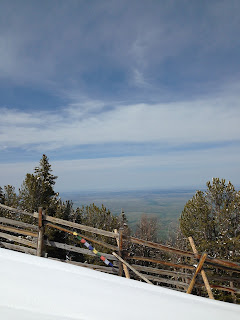I have been meaning to build a set of oars for a long time. Oar making is not extremely difficult it is however very tedious, so getting into the right mindset can be complicated.
If you are interested in building your own oars there is a great article The Long Oars of Pete Culler by Rick Cahoon. I learned how to build oars at the Northwest School of Wooden Boat Building and Cahoon's article was featured, its worth the time and its free.
While at the school we built Spruce and Ash oars from one solid piece. I do have a couple of pieces of Spruce that could become solid oars but it wastes quite a bit of good wood. I highly recommend laminating the blade edges on (third photo).
It all starts with creating the blank. This thing looks really clunky but i swear if you take your time and follow the steps you will find the oar buried in the blank.
There are three decisions that need to be made at the very beginning. 1) Overall length 2) Max thickness of loom (shaft) 3) handle shape 4) Blade shape 5) location of oar wrap
Lets discuss these.
1) Overall length, i always make the blank a inch or two longer than what i want the finished oar to be.
2)The max thickness of the loom gives the dimensions of the loom blank. For example if you want an oar that is 1 1/2" round the blank needs to be 1 /12" x 1 1/2" square.
3) The handle shape can be copied from an existing handle. Be sure to cut out a cardboard or thin plywood pattern, mark a center-line and use this pattern to lay out both handles, they need to match.
4) Blade Shape, This is extremely personal. If you want to get people revved up start talking about blade shapes, everyone has a opinion. Here is mine. Start with a shape you like, copy the oars you have now. I like to build them a little bigger than necessary so that i can trim them down. Always remember with wood you can take material away but until they invent a board stretcher there is no adding material back.
Anyhow draw out the blade with a marked center-line so that you can layout the oars exactly the same.
5)Location of oar wrap. I use this location to decide how far down from the handle i want the square part of the loom to go. Leaving a portion of the oar square adds weight by the handle and helps in balancing the oar.
Before i start with the spar gauge (marking gauge in the Cahoon article) i use a band saw to cut out the rough shapes of the blades and tapers on the loom. I always leave the handle for after the loom.
Working from the center-line i use the draw knife for the bigger chunks and a hand plane and spoke shave for the closer work. Remember when rounding the loom be as exact as you can be, if its not exact you will be able to tell.
After the loom is round i draw out and cut the handle.
The left handle has been rounded with the spar gauge and the right one has just been cut out.
Above is a pick of the handle at 16 or 32 sides (right before sanding).
At this point the looms and handles are done and the blades are rough cut. So its time to shape the blade. I really like to use a radius plane to back out the blade along the spine. There are a lot of shapes out there where this is unnecessary so pick one your capable of creating. Once all of the material has been removed and you have done a final sand its time to finish them off.
I use cheep ass spar varnish, pine tar and turpentine. The handles are coated in 50/50ish pine tar and turpentine. This protects the wood from rot and leaves a smooth finish when dry and a slightly sticky finish when wet. The cheep ass varnish is used on everything else.
Ok, so your done with your new oars i recommend putting some fiberglass cloth on the blade tips. There are some instructions here. Install the fiberglass tip after you have used the oars a few time and decided that you like the blade shape. It is not impossible to trim a blade after you have capped it, it just sucks a little.
If done correctly there should be one hell of a pile of shavings,
and a fantastic set of oars. Now you need to decide how your going to wrap them. I like to use braided polly. Its cheep easy to get and durable. Instructions are here and here.
Here are some other links to oar building. Here, here, and here.
Cheers,
PS. if you have any questions feel free to ask.
































